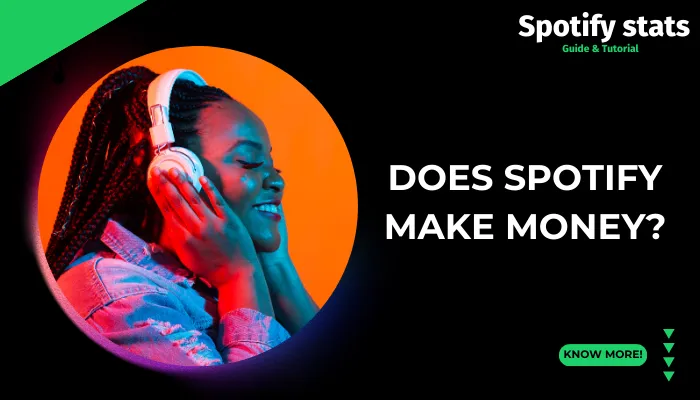Do you also want to know does Spotify make money? Well, Spotify is a well-known music streaming service with millions of users globally. We will examine sources of revenue, subscription tactics, and the complex dynamics between the free and premium levels of Spotify.
This article will delve into Spotify’s revenue model and investigate how it generates income and whether it is profitable.

Breaking Down Spotify’s Revenue Streams
You asked does Spotify make money? The answer is yes. However, a more complicated story would be how much does this platform make and if it earns regularly. Let’s dig into that.
- Revenue: Subscriptions and advertisements are the main sources of revenues for Spotify. However, even though it has significant income, the question of profitability remains owing to the large expenses incurred in running such a service.
- Profitability: High costs lead to net losses even though Spotify brings in significant revenue. The company has experienced fluctuations in profits with some quarters reporting positive earnings while others have posted losses due to high investments and expenditure.
Primary Revenue Streams
On Spotify, where does this money come from that compensates artists? In this part, we take a closer look at Spotify’s business model and identify its main revenue streams that make the platform work while contributing to the artist payouts.
A. Subscription Revenue
This has contributed greatly to making profits for this platform since there exist diverse subscription plans for different users on Spotify.
B. Spotify Premium Plans
These premium plans from Spotify have better features and user experiences compared to their free tier alternative.
- Individual Plan: $9.99/month
- Music without ads
- Offline play
- No limit skips
- Family Plan: $14.99/month
- Up to six accounts
- Family Mix playlist
- Parental controls
- Student Plan: $4.99/month
- Discounted rate for students
- Includes Hulu and SHOWTIME
Premium subscribers are more lucrative than free users hence these plans form an essential part of the platform’s revenue stream, especially the family plan which records significant subscription increases.
Spotify Subscription Plans
| Plan | Price | Features |
|---|---|---|
| Individual | $9.99/month | Ad-free, offline listening, skips |
| Family | $14.99/month | 6 accounts, Family Mix, parental controls |
| Student | $4.99/month | Discounted rate, includes Hulu & SHOWTIME |
C. Ad-Supported Revenue
Spotify’s free tier attracts people who don’t want to pay for music streaming services; this is where the ads come in. The ad-supported model makes Spotify accessible to a wider audience, thereby becoming one of its major revenue streams.
Types of Advertisements
- Audio Ads: These ads can be targeted at users based on their preferences and what they listen to as played between songs.
- Video Ads: Users watch these to get 30 minutes of ad-free listening, providing a valuable exchange.
- Display Ads: These ads can promote different products and services when displayed on the app interface.
Advertising Partnerships
- Brand collaborations for targeted ad campaigns
- Sponsored playlists and podcasts that let brands reach specific audiences
- Innovative ad formats that engage users in creative ways
Advertising income does not only support the free tier but also enables Spotify to invest in technology and content that enhances user experience.
Other Revenue Sources
Although Spotify relies heavily on subscriptions as a means of making money, it does not end there. Here, we look at how Spotify keeps the music going through other income streams.
A. Merchandising
Spotify sells artist or music-related merchandise as another source of revenue. This includes branded clothing, accessories, and artist-specific merchandise making use of its platform for promotional purposes.
B. Live Events and Ticket Sales
Through such events which are mostly advertised through the app, Spotify collaborates with artists earning from ticket sales. They help strengthen the bond between musicians and fans because of which Spotify has gained brand loyalty among its customers.
C. Podcasts and Exclusive Content
Spotify has been splurging on podcasts and exclusive content arrangements to increase its user base and attract advertisers. The company’s acquisitions like Gimlet Media as well as exclusives with top podcasters have made Spotify appear as the key player in the industry.
Spotify’s Cost Structure
Knowing what Spotify incurs as expenses is paramount to understanding its profitability also helping us understand does Spotify make money.
- Licensing and Royalty Payments
- To Artists and Labels: The majority of inflows are used to pay artists, and creators of music since this is one of the highest expenses for Spotify that reflects its commitment towards equitable remuneration of such professionals.
- Technology and Infrastructure Costs
- Maintaining servers and ensuring seamless streaming experiences. This encompasses investment in high-quality streaming technology, and implementation of reliable redundancy measures to create a safety net against instances that may jeopardize services thereby compromising the security of the platform.
- Marketing and Advertising Expenses
- Heavy investment in advertising to attract users who will stay subscribed. This incorporates global marketing campaigns, partnerships with influencers, and promotion deals.
- Administrative and Operational Costs
- Salaries, office spaces, and other operational expenditures. These costs are essential for day-to-day running as well as supporting the growth strategy of the organization.
| Cost Category | Description |
|---|---|
| Licensing and Royalties | Payments to artists and labels |
| Technology and Infrastructure | Server maintenance & tech development |
| Marketing and Advertising | Campaigns to attract & retain users |
| Administrative & Operational | Salaries, office spaces & other expenditures |
Challenges and Opportunities
Spotify offers artists a worldwide platform, but this does not guarantee instant riches. This examination looks at the hindrances that face artists regarding Spotify’s payout system. We will look at challenges and opportunities to understand does Spotify make money.
A. Challenges
- High Royalty Costs
- This results in low profitability due to a high percent of revenue being paid out as royalties. The costs are negotiated between music labels and can fluctuate based on market dynamics.
- Competition from Other Streaming Services
- Apple and Amazon are among other giants who provide stiff competition to Spotify which has unique strengths that each competitor possesses hence making the streaming industry very competitive.
- Market Saturation and User Growth
- Due to the saturation of the market it becomes harder to find new listeners. Therefore, in order to attract more users amidst many rivals in the market, Spotify must be innovative enough while running its business processes through changes resulting from highly advanced technological changes by considering motivations that will drive customers into using their service instead of those offered by competitors.
B. Opportunities
- Expansion into New Markets
- Growing presence in regions like Asia and Africa. These upcoming markets have witnessed an increase in internet penetration rates coupled with a rise in smartphone usage thereby creating massive potential growth opportunities for firms venturing into them.
- Growth in Podcasting and Exclusive Content
- Podcast investments and exclusive content for attracting users. Subsequently, exclusive as a key driver of attracting new subscribers is another objective of Spotify’s efforts to expand its presence in the market.
- Technological Developments and User Involvement
- Enhancing user experience with AI and machine learning. Through personalized playlists and recommendations that make users remain loyal to the platform.
Conclusion
In summary, does Spotify make money? Yes, but this profit is usually dwarfed by high costs and intense competition. The company has good prospects in terms of new markets and content creation but has a number of challenges to overcome.
Spotify must keep on innovating itself while keeping an eye on its strategy as it makes strategic investments which is paramount for its survival in the ever-changing world of the music streaming industry.
